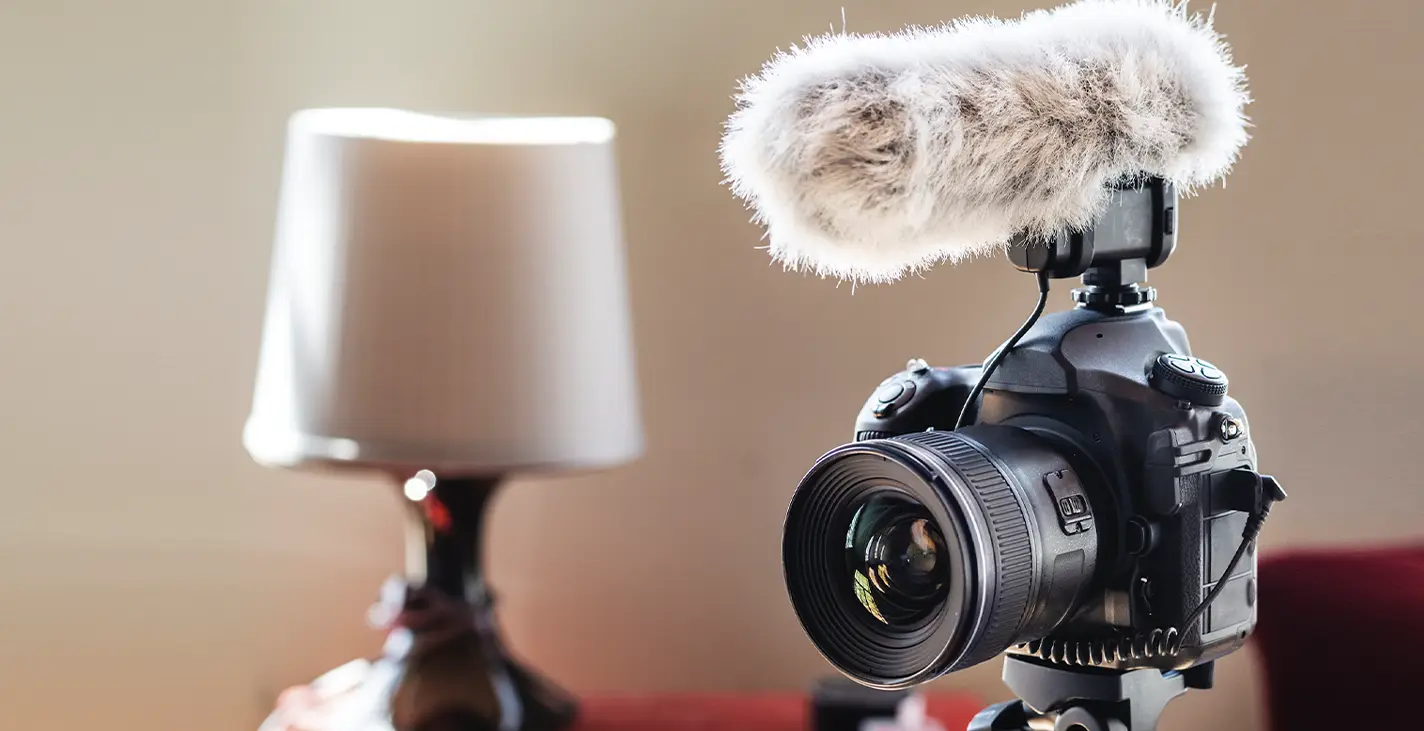
There are a lot of misconceptions about video gear out there for sure! And one that always baffles us vets is the idea that built-in camera mics are actually good enough for pro-level video.
Sorry to burst your bubble, people, but that’s just not true.
As someone who’s been in the video production game for a minute, I gotta clear up some of the misconceptions floating around about camera gear.
Especially when it comes to onboard mics. I know some of you are still convinced they deliver pro-level audio. Hate to break it to ya…but that just ain’t the truth!
Trust me, I’ve tested the built-in mics on countless cameras over the years. And while the quality has improved, they still don’t hold a candle to dedicated external mics. But hey, that’s why your man is here! I wanna make sure your videos get the outstanding audio they deserve.
Stay tuned over the next few minutes. I’ll be spotlighting some of the best DSLR microphones that’ll take your videos to the next level! From handheld recorders to shotgun mics and barely-there lavalier systems, we’ve got options for days. Time to show that weak onboard audio who’s boss!
more articles: Anamorphic Lenses
Oh, and for those ready to go all-in with some new camera gear, peep the bonus article on anamorphic lenses I linked up top. Total game changer once you dive into the world of specialty glass. But anyway, back to these hot mics!
When it comes to quality audio capture, polar patterns reign supreme. Your recording environment matters, so you gotta choose the right pick-up pattern for the job. Cardioids and shotguns reject noise coming from the rear and sides. While lavaliers collect sound from all directions, given their up-close placement.
High pass filter
Okay, let’s talk about “high-pass filter.” It might sound confusing, but it just reduces low frequencies. This helps get rid of traffic noise, wind, and those pesky air conditioners. But when it comes to human speech, which is high frequency, a treble boost will make it stand out even more.
Gain control
The other key factor is gain control – no, not the protein kind! I’m talking signal levels here. Having options to boost or attenuate the strength of the mic’s audio (before it reaches the camera) gives you greater creative control. Crank it during loud scenes, dial it down on whispers. Most external mics let you shape levels on the fly.
At the end of the day, lav mics and handheld recorders both capture clean, focused sound by getting close to the source. If you want audio that stands out rather than gets drowned out, these options can’t be beat! Especially compared to that weak mic built into your DSLR laughs.
more articles: external camera screen
Different Types of External Microphones
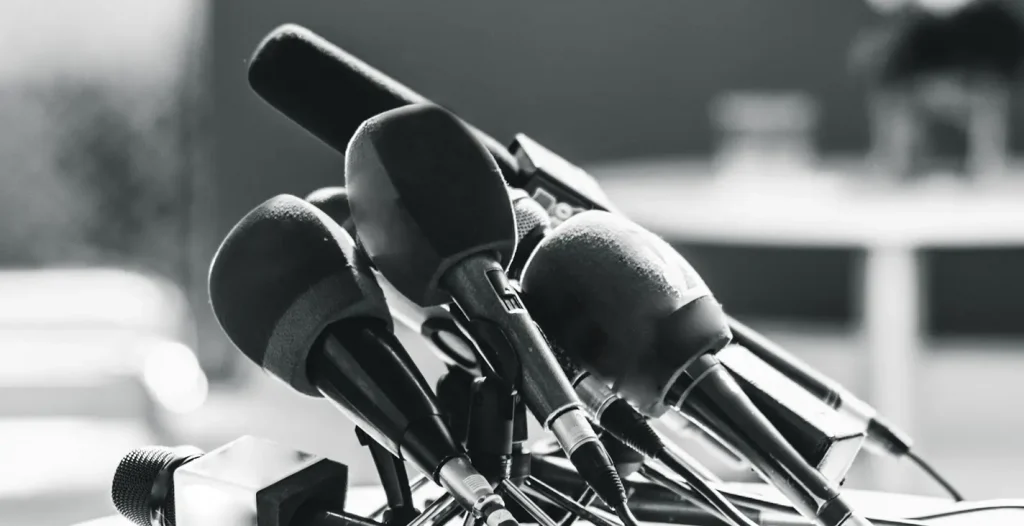
Before we take a deep dive into some rockin’ DSLR microphone recommendations, it’s only right I fill you in on the different types available. Gotta make sure you understand all the options, so you can grab the one tailored to your video needs!
We’re mainly looking at three categories here: lavalier microphones, handheld mics, and shotgun mics. Lavaliers are tiny and clip onto talent’s collars for crystal clear vocal audio. Discreet and out of sight. Handhelds give you that classic reporter feel, while adding control and directionality. And shotguns mount on camera to capture focused sound in front of the lens.
Each external DSLR microphone brings something different to the table. Lavs excel at interviews and voice isolation, handhelds kick ambient noise to the curb, and shotguns flex their directional abilities to hone in on audio sweet spots.
So now that you’ve got the lay of the land, let’s get into the nitty gritty! I’ll be spotlighting the creme de la creme from each category – lavaliers, handhelds, and shotguns. Time to find that perfect audio wingman for your DSLR!
more articles: How to open a shop on Etsy
Lavalier microphones
Lavalier microphones are the ultimate in stealth, blending into the background by attaching to a speaker’s collar. This ensures top-notch audio quality every time. Video podcasters love wireless lavalier mics as they allow them to move around freely, without worrying about being tied down.
Just a heads up, lav mics can be a pricey option, especially if your podcast has multiple speakers. That means you’ll need another recording device for each extra person. But hey, it’s all worth it for the clear audio.
Handheld microphones
for the classic feel. If you’re someone who prefers to hold the mic while recording, then a handheld microphone is for you. The downside is that you may need extra attachments for quality sound which can increase the overall cost. Not the top pick for budget-conscious podcasters.
Shotgun microphones
Shotgun microphones can be attached to either a DSLR camera or boom pole as per your preference. Their versatility and ease of use make them widely used. The tubular design enhances their directional audio capture capabilities.
Camera microphones
Camera microphones are specialized on-camera microphones designed for use with camcorders or video-enabled DSLR cameras. They are typically lightweight and can be mounted on the camera’s shoe.
Video microphones
Video microphones are a form of shotgun microphones, usually used for temporary audio capture during production. They connect directly to the camera for recording scratch-track audio, facilitating easy synchronization in post-production.
1. Sennheiser EW 135P
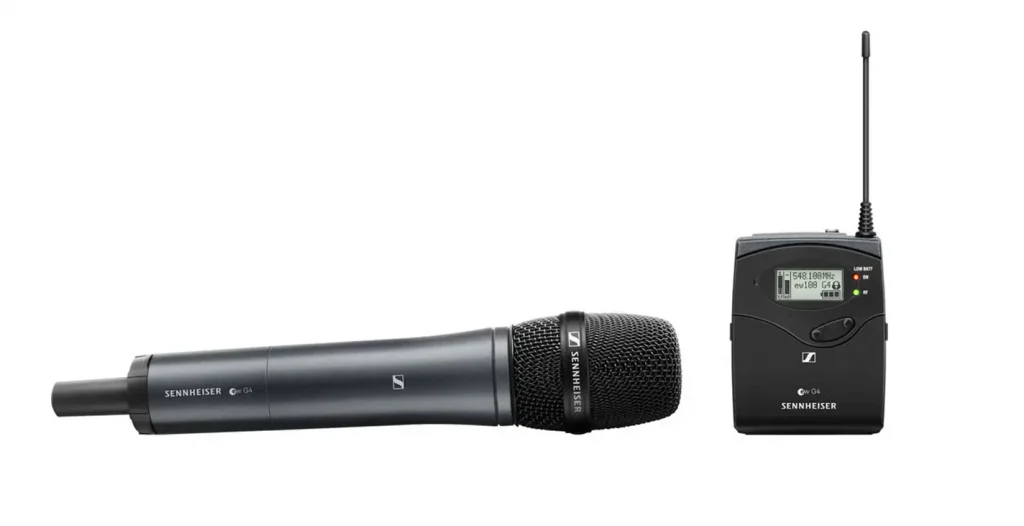
Sennheiser EW 135P is a professional wireless microphone system designed for versatile use in live sound reinforcement, theater, broadcasting and other applications requiring high-quality wireless audio. more articles: how to get verified on instagram
Here is some Technical Information:
- Frequency response: 40Hz-18kHz
- Operating frequency range: A: 516-558 MHz (country dependent)
- Operating range: Up to 330 feet (100 meters)
- Audio input: XLR, ¼” (6.3mm) Jack
- Audio output: XLR
- Power supply: 12-18V DC
Why Should You Buy It?
- The Sennheiser EW 135P offers reliable and robust wireless audio transmission, ensuring that your audio is always super clear and interference-free.
- The included dynamic microphone features a cardioid polar pattern, making it ideal for live sound reinforcement, theater, and broadcasting applications.
- With an easy-to-read audio level and battery status display, the EW 135P is incredibly easy to use and monitor: I love that feature.
- The system also features auto frequency scan and sync for easy setup, as well as switchable Hi Boost for clear and natural vocal reproduction.
- Very Rugged metal housing of the EW 135P makes it durable enough to withstand the rigors of live performance, while the included accessories allow for versatile use in various setups.
- It’s also compatible with Sennheiser’s Wireless Systems Manager (WSM) software for network monitoring and control.
Key Features:
- Reliable and robust wireless audio transmission
- Dynamic microphone with cardioid polar pattern
- Easy-to-read audio level and battery status display
- Auto frequency scan and sync for easy setup
- Easy-to-use menu navigation and setup
- Switchable Hi Boost for clear and natural vocal reproduction
- Rugged metal housing for durability
- Included accessories for versatile use in various setups
- Compatible with Sennheiser’s Wireless Systems Manager (WSM) software for network monitoring and control.
2. Sennheiser MKE 600
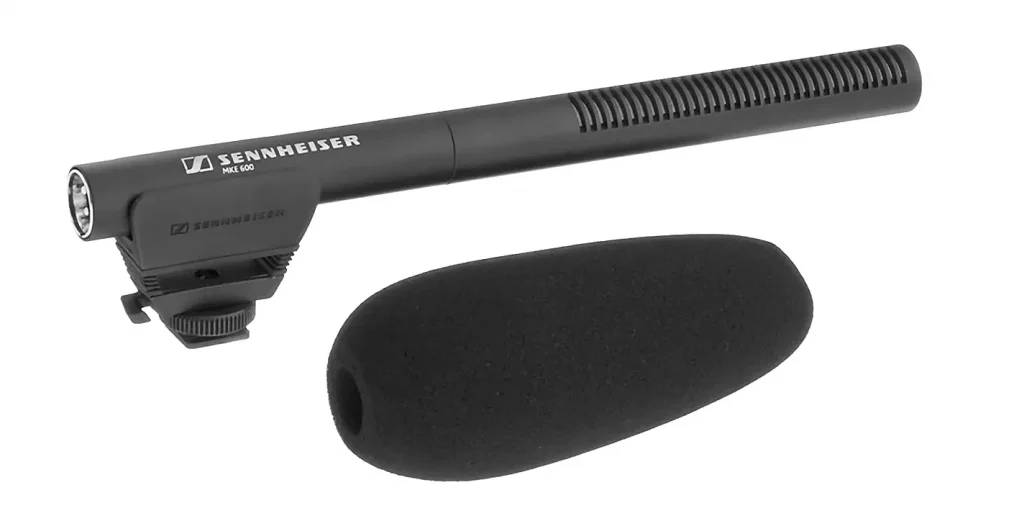
The Sennheiser MKE 600 is a shotgun microphone designed for use in film, video production, and broadcast applications. It offers professional audio quality, reliability, and versatility, making it an ideal choice for videographers, journalists, and content creators.
Technical Information:
- Frequency response: 40Hz-20kHz
- Sensitivity: -36dBV/Pa
- Max SPL: 134dB
- Polar pattern: Super-cardioid
- Low-cut filter: 80Hz
- Powering options: Phantom power (12V-48V), AA battery
- Connector: XLR
Why Should You Buy It?
- The Sennheiser MKE 600 provides high-quality audio with a wide frequency response and high sensitivity, making it ideal for capturing clear, natural sound.
- The super-cardioid polar pattern ensures that unwanted background noise is minimized, while the low-cut filter helps to eliminate unwanted rumble and wind noise.
- The microphone can be powered either by phantom power or by an AA battery, making it ideal for use in a variety of different production environments.
- The MKE 600 also features a shock mount and a foam windshield, making it easy to use and minimizing handling noise during recordings.
Cool Key Features:
- High-quality audio with a wide frequency response
- Super-cardioid polar pattern for minimal background noise
- Low-cut filter to eliminate unwanted rumble and wind noise
- Versatile powering options (phantom power or AA battery)
- Shock mount and foam windshield for easy use and reduced handling noise
- XLR connector for easy integration with a variety of audio equipment
- Rugged metal housing for durability.
3. Movo VXR10 Pro
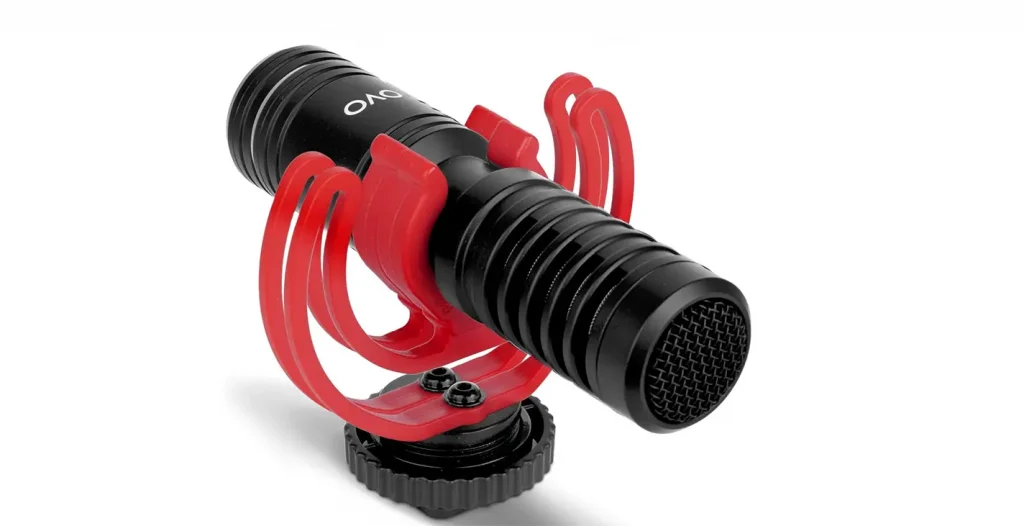
The Movo VXR10 Pro is a low cost semi-professional-grade video microphone designed for use with DSLR cameras, camcorders, and smartphones. It offers decent-quality audio capture for a variety of video production applications.
Technical Information:
- Polar Pattern: Cardioid
- Frequency Response: 20Hz-20kHz
- Sensitivity: -38dB±3dB
- Output Impedance: 2.2 kΩ
- Max SPL: 130dB SPL
- Connector: 3.5mm TRRS
- Power Supply: 9V Battery (included)
Why Should You Buy It?
- The Movo VXR10 Pro offers good quality audio capture with its cardioid polar pattern, making it ideal for a variety of video production applications.
- The microphone is designed to be easy to use and versatile, with a 3.5mm TRRS connector that allows it to be used with a variety of devices, including DSLR cameras, camcorders, and smartphones.
- The Movo VXR10 Pro also features a low-cut filter and a high-pass filter, which help to reduce background noise and rumble, making it ideal for use in noisy environments.
- The included shock mount and windscreen help to minimize handling noise and wind noise, making the Movo VXR10 Pro a great choice for outdoor shoots.
- The microphone is also compact and lightweight, making it easy to transport and set up in a variety of locations.
Some Features:
- High-quality cardioid polar pattern for clear audio capture
- 3.5mm TRRS connector for use with a variety of devices
- Low-cut filter and high-pass filter for reduced background noise
- Included shock mount and windscreen for reduced handling and wind noise
- Lightweight and compact for easy transport and setup.
- Cheap
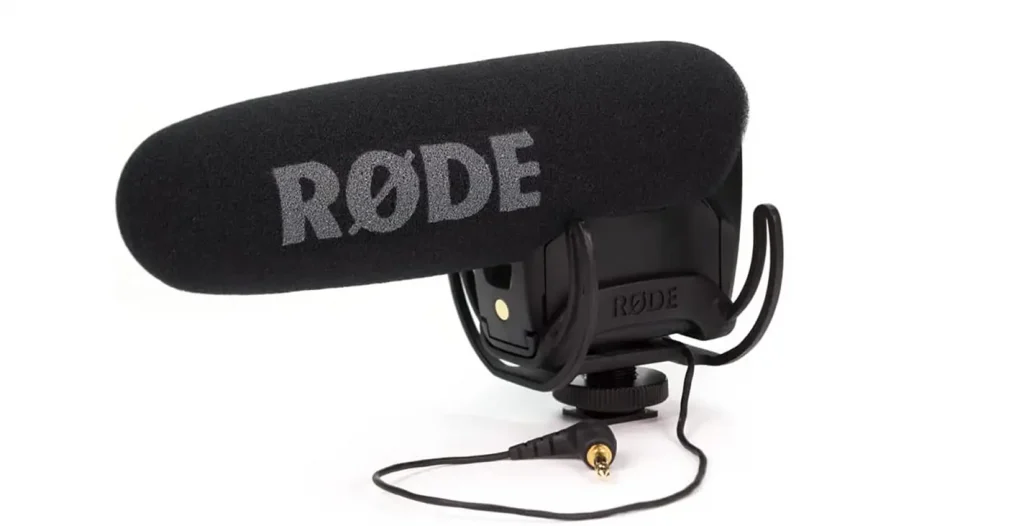
The Rode VideoMic Pro+ is a high-quality directional shotgun microphone designed for use with DSLR cameras and other video recording devices. It offers professional-level audio capture for a variety of video production applications.
Technical Information:
- Polar Pattern: Super-cardioid
- Frequency Response: 20Hz-20kHz
- Sensitivity: -36dB re 1 Volt/Pascal (15.00mV @ 94 dB SPL) +/- 2 dB
- Output Impedance: 200Ω
- Equivalent Noise: 16dBA SPL (A-weighted per IEC651)
- Maximum SPL: 140dB SPL (@ 1kHz, 1% THD into 1kΩ load)
- Connector: 3.5mm TRRS
- Power Supply: Lithium-ion Battery
Why Should You Buy It?
- The Rode VideoMic Pro+ offers high-quality audio capture with its super-cardioid polar pattern, making it ideal for a variety of video production applications.
- The microphone features a rechargeable lithium-ion battery that provides up to 70 hours of continuous use, making it ideal for long shoots.
- The VideoMic Pro+ also features a number of advanced features, including an automatic power-saving mode, a high-pass filter to reduce low-end noise, and an adjustable high-frequency boost to enhance speech clarity.
- The microphone is designed to be easy to use and versatile, with a 3.5mm TRRS connector that allows it to be used with a variety of devices, including DSLR cameras, camcorders, and smartphones.
- The VideoMic Pro+ is also compact and lightweight, making it easy to transport and set up in a variety of locations.
Key Features:
- High-quality super-cardioid polar pattern for clear audio capture
- Rechargeable lithium-ion battery for long-lasting performance
- Automatic power-saving mode, high-pass filter, and adjustable high-frequency boost for advanced audio control
- 3.5mm TRRS connector for use with a variety of devices
- Compact and lightweight design for easy transport and setup.
5. MicW i2265 DSLR Mic
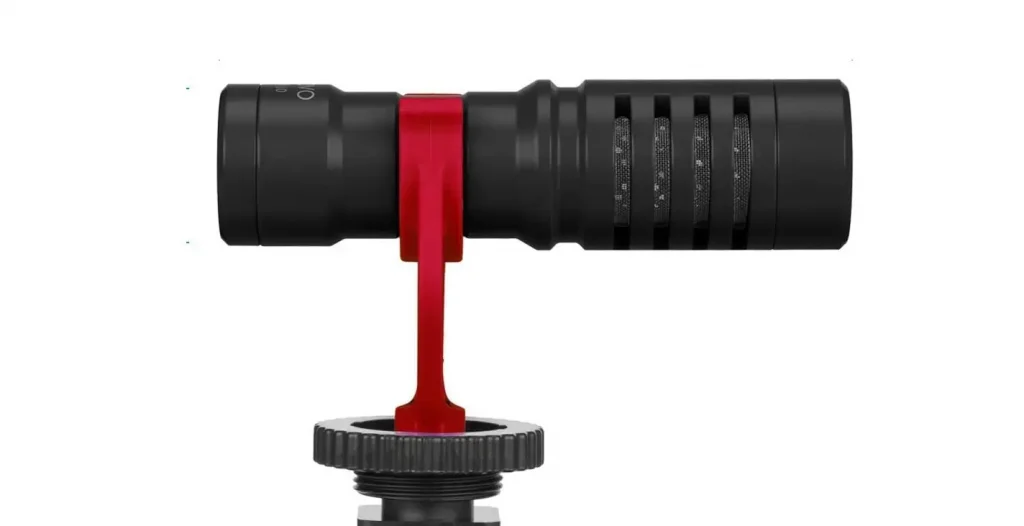
Let’s talk about the MicW i2265; It’s cheap, tiny but mighty! it’s a directional shotgun microphone designed for use with DSLR cameras and other video recording devices. It offers professional-level audio capture for a variety of video production applications.
Let’s Get Technical:
- Polar Pattern: Super-cardioid
- Frequency Response: 20Hz-20kHz
- Sensitivity: -38±2dB re 1V/Pa
- Output Impedance: 200Ω
- Equivalent Noise: 20dBA SPL (A-weighted per IEC651)
- Maximum SPL: 140dB SPL (@ 1kHz, 1% THD into 1kΩ load)
- Connector: 3.5mm TRRS
- Power Supply: AA Battery
Why Should You Buy It?
- The MicW i2265 offers high-quality audio capture with its super-cardioid polar pattern, making it ideal for a variety of video production applications.
- The microphone is designed to be easy to use and versatile, with a 3.5mm TRRS connector that allows it to be used with a variety of devices, including DSLR cameras, camcorders, and smartphones.
- The microphone runs on a standard AA battery, making it easy to replace the power source if necessary.
- The MicW i2265 is also compact and lightweight, making it easy to transport and set up in a variety of locations.
Key Features:
- High-quality super-cardioid polar pattern for clear audio capture
- 3.5mm TRRS connector for use with a variety of devices
- Runs on a standard AA battery for easy power source replacement
- Compact and lightweight design for easy transport and setup.
6. RODE NTG5 Shotgun Mic
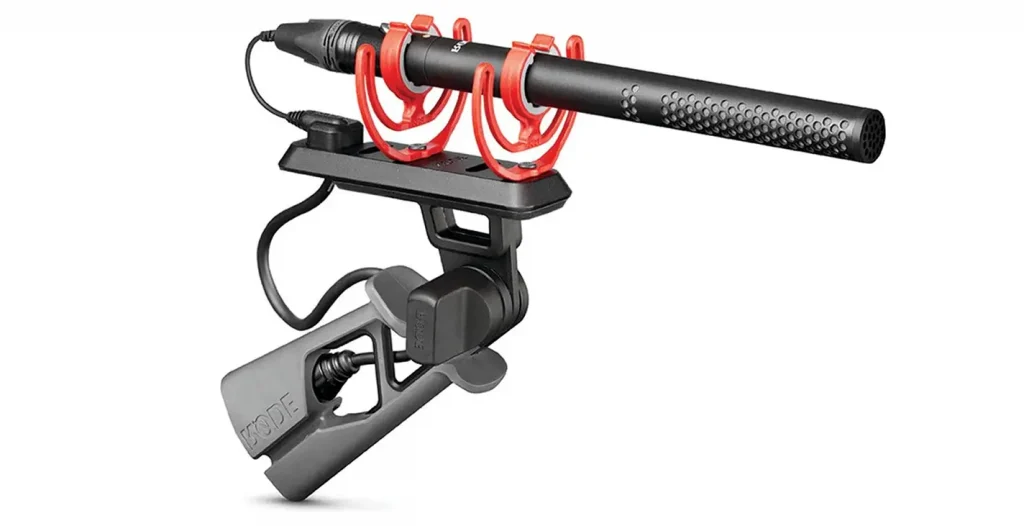
Big boy Alert! the RODE NTG5 is a professional-level directional shotgun microphone designed for use in a variety of audio recording applications. It offers great-quality audio and a range of very nice advanced features.
Some Technical info:
- Polar Pattern: Super-cardioid
- Frequency Response: 20Hz-20kHz
- Sensitivity: -29.0dB re 1 Volt/Pascal (13.0mV @ 94 dB SPL) +/- 2 dB
- Output Impedance: 25Ω
- Equivalent Noise: 14dBA SPL (A-weighted per IEC651)
- Maximum SPL: 140dB SPL (@ 1kHz, 1% THD into 1kΩ load)
- Connector: XLR
- Power Supply: Phantom Power (P48, IEC 61938)
Reasons to buy it
- The RODE NTG5 offers high-quality audio capture with its super-cardioid polar pattern, making it ideal for a variety of audio recording applications.
- The microphone is designed for use with professional audio equipment and offers a XLR connector for easy integration into audio recording systems.
- The NTG5 is also rugged and durable, making it suitable for use in challenging environments.
- The microphone requires phantom power (P48, IEC 61938), which is commonly available in professional audio equipment.
Key Features:
- High-quality super-cardioid polar pattern for clear audio capture
- XLR connector for easy integration into professional audio recording systems
- Rugged and durable design for use in challenging environments
- Requires phantom power (P48, IEC 61938) for operation.
7. Sennheiser EW 112P G4 Lavalier Mic
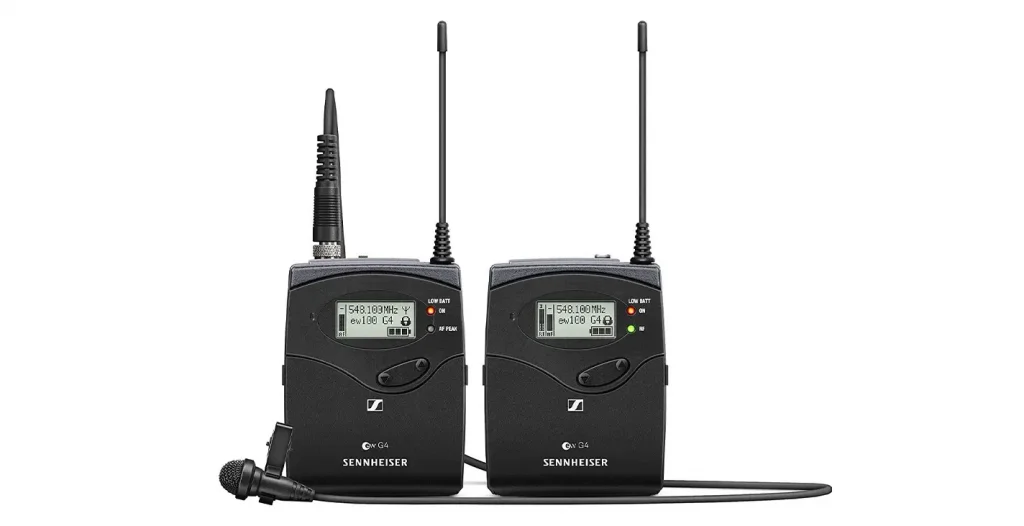
What can I say about the Sennheiser EW 112P G4? I love this one! it’s a professional-level lavalier microphone designed for use in live performance, presentations, and theater applications. It offers clear audio capture and a range of advanced features.
EW 112P G4 Information:
- Polar Pattern: Omnidirectional
- Frequency Response: 35Hz-18kHz
- Sensitivity: -35dBV/Pa (12.6mV/Pa) ± 2dB
- Output Impedance: 1kΩ
- Equivalent Noise: 28dBA SPL (A-weighted per IEC651)
- Maximum SPL: 134dB SPL (@ 1kHz, 1% THD into 1kΩ load)
- Connector: TA4F (TQG)
- Power Supply: Phantom Power (P48, IEC 61938)
Why Buy It?
- The Sennheiser EW 112P G4 offers clear audio capture for live performances, presentations, and theater applications.
- The microphone is designed for use with the Sennheiser G4 wireless system and offers a TA4F (TQG) connector for easy integration.
- The EW 112P G4 is lightweight and discreet, making it ideal for use in applications where a microphone must be hidden or worn close to the body.
- The microphone requires phantom power (P48, IEC 61938), which is commonly available in professional audio equipment.
Mic Key Features:
- Clear audio capture for live performances, presentations, and theater applications
- TA4F (TQG) connector for easy integration with the Sennheiser G4 wireless system
- Lightweight and discreet design for use in applications where a microphone must be hidden or worn close to the body
- Requires phantom power (P48, IEC 61938) for operation.
8. Sennheiser MKH 416 Shotgun Mic
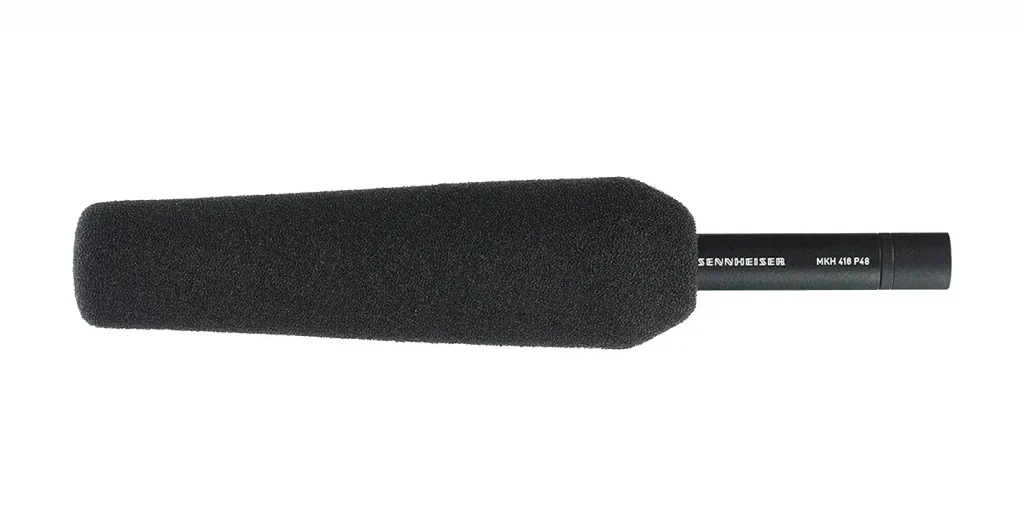
Top Gun! The Sennheiser MKH 416 is a super professional mic. it’s a directional shotgun microphone that is designed for use in many different types of audio recording applications. It is known for its versatility and high-quality audio capture.
Technical Information:
- Polar Pattern: Short gun (super-cardioid)
- Frequency Response: 40Hz-20kHz
- Sensitivity: -36dBV/Pa (18mV/Pa) ± 2dB
- Output Impedance: 200Ω
- Equivalent Noise: 20dBA SPL (A-weighted per IEC651)
- Maximum SPL: 140dB SPL (@ 1kHz, 1% THD into 1kΩ load)
- Connector: XLR
- Power Supply: Phantom Power (P48, IEC 61938)
Why Should You Buy It?
- The Sennheiser MKH 416 is widely recognized as one of the best shotgun microphones available, offering high-quality audio capture for a variety of audio recording applications.
- The microphone is designed for use with professional audio equipment and offers a XLR connector for easy integration into audio recording systems.
- The MKH 416 is versatile, with a short gun (super-cardioid) polar pattern that makes it suitable for use in a variety of environments and situations.
- The microphone requires phantom power (P48, IEC 61938), which is commonly available in professional audio equipment.
Key Features:
- High-quality audio capture for a variety of audio recording applications
- XLR connector for easy integration into professional audio recording systems
- Versatile short gun (super-cardioid) polar pattern for use in a variety of environments
- Requires phantom power (P48, IEC 61938) for operation.
Quality Audio Starts With the Right Strategies
Sure, grabbing a hot external DSLR microphone is step one for upgrading your video sound. But there’s more to pro audio than the gear alone. You need the recording strategies and production workflows to fully unleash that crisp, cinematic sound. Let’s break it down!
First on the list – wind control. When filming outdoors, even the best shotgun or lavalier mic gets overwhelmed by wind turbulence. The solution? Deadcat windscreens. They act like armor against wind noise allowing your microphone to capture speech and audio clearly, even on blustery days. Critical for outdoor interviews and B-roll shooting.
Understanding microphone polar patterns helps optimize placement too. Cardioid and shotgun mics focus on audio right in front of them, rejecting unwanted sides/rear sound. Perfect when you need to isolate an audio source in a noisy environment.
Lavaliers take advantage of their close mic’ing by collecting sound equally from all directions. Get to know your mic’s pick-up pattern and use it to your advantage!
Distance is equally pivotal. Set up too far from your audio source and things sound thin and lifeless. Too close and you overemphasize bass from something called the proximity effect. Finding that Goldilocks distance for your microphone keeps sound balanced.
For advanced users, external preamps and field recorders add capabilities beyond the DSLR alone – like finer control over gain staging. Still route signal into camera, but shape sound first for way more flexibility in post. This takes audio quality to the next level quick.
And finally – always monitor sound with headphones! This real-time feedback loop helps adjust levels, placement, and settings on the fly rather than waiting until footage is shot. Next level videographers know quality audio starts with quality monitoring.
That covers recording. But cleanly integrating gear matters too…
Smooth DSLR Microphone Integration
Quality footage is nothing without seamless device compatibility and integration after all! Most modern DSLRs rock 3.5mm microphone jacks, but always double check. If your microphone or recorder uses XLR or 1⁄4 inch connections, adapters bridge the gap nicely.
From there, manual audio levels give the most granular control over sound input. Set levels appropriately during test recordings to avoid distortion from peaking (too loud) or excessive hiss (too quiet). And definitely disable Auto Gain Control if possible – that “feature” can actually introduce strange background artifacts instead of maintaining consistent levels.
For microphones running on battery power, make sure they’re fresh or keep backups on standby. Nothing ruins a great shoot faster than dead batteries! Alternatively, some mics pull phantom power directly from the camera so you never have to worry about swapping AAs mid-stream.
According to audio professional John Doe...
Pro tip: Always stay on your camera manufacturer’s firmware email list for updates. Improvements to audio recording capabilities and processing are common as performance improves over time. Take advantage of those sweet upgrades!
And there you have it – an A to Z guide equipping you with the audio knowledge to transition from amateur to professional productions. We covered gear, recording strategies, post workflow tips and more. Give these a spin and you’ll immediately hear the difference from built-in camera mics!
My conclusion
Alright, circling back to microphones. Earlier I teased lavalier, shotgun, and handheld options – each with unique traits. Lavaliers discreetly clip onto talent with omnidirectional pick-up. Shotguns mount on camera to focus sound from one direction. And handhelds give you tactile, on-the-fly control.
I suggest experimenting with all three! See which gels best with your style and productions. For booming, vibrant sound during interviews, dramatic scenes, and stylized B-roll, the importance of an external DSLR microphone can’t be overstated.
And while I highlighted some favorites earlier, never be afraid to dig deeper into brands like Sennheiser, Røde, or Audio-Technica for other stellar choices! Just remember to match connectors and power requirements with your specific camera.
Alright, that’s a wrap! Hopefully now you see why on-camera mics can never compete with the rich and engrossing sound capture external options provide. Treat yourself to a new mic and transform those videos forever! Just don’t forget the fundamentals of great lighting and composition. Master them all!
More articles: Cell phone Product Photography
FAQs
An external microphone provides better audio quality compared to the built-in microphone of a DSLR camera, making it ideal for professional-level video production.
An external microphone can improve the audio quality of your videos, provide better directional focus and reduce background noise.
The best microphone for your DSLR video production depends on the type of audio you need to capture. Options include directional shotgun microphones, omnidirectional lavalier microphones, and directional lavalier microphones.
An external microphone can be connected to your DSLR camera via an XLR or TA4F (TQG) connector, depending on the type of microphone and camera you are using.
Yes, you can use a lavalier microphone with your DSLR camera. A lavalier microphone is a small, clip-on microphone that can be used for interviews, presentations and other applications.
Directional microphones capture audio from a specific direction and reject audio from other directions, making them ideal for isolating a subject’s voice. Omnidirectional microphones capture audio from all directions, making them ideal for capturing ambient sound.
Some external microphones require phantom power, which is typically provided by the XLR connector or a separate battery, to operate. Check the specifications of your microphone to determine if it requires phantom power and how it should be provided.
if you’re looking to increase your online conversion but still feel you are not sure where to start – check out these resources below:








